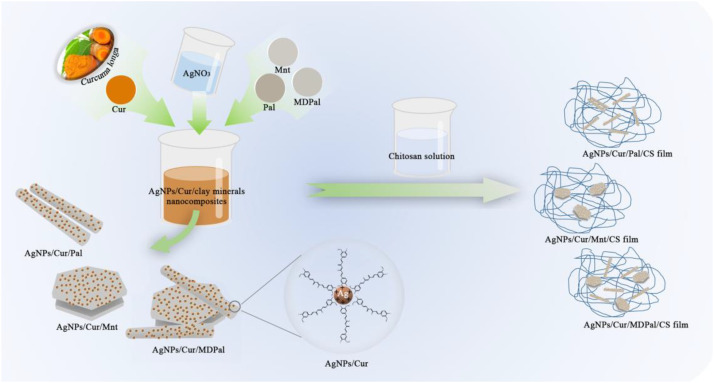Abstract
It is popular that natural organics are served as green reducing and end-capping reagent for synthesis of func-tional nanoparticles. In this study, curcumin, a natural pigment, was employed to prepare silver nanoparticles (AgNPs) as a coloring, reducing and end-capping agent by an eco-friendly, economic and facile approach in the presence of different clay minerals, including palygorskite, montmorillonite and mixed-dimensional palygorskite clay. It was found that the phenolic hydroxyl groups or carbonyl groups of curcumin played a crucial role to reduce silver ions into AgNPs with the ginger color. Meanwhile, incorporation of clay minerals could induce the in-situ heterogeneous nucleation of AgNPs on the surface or/and interlayer of the involved clay minerals. It effectively prevented from the aggregations and resulted in uniform dispersion of AgNPs with a diameter of 30-40 nm. Furthermore, the as-prepared nanocomposites exhibited a higher antioxidant (>90%) and antibac-terial activity. Due to the synergistic effect of each component among the nanocompositions, the nanocomposites derived from different clay minerals were employed as multifunctional nanofillers to design functional chitosan composite films. By contrast, the chitosan composite films containing curcumin-capped AgNPs/mixed-dimen-sional palygorskite clay nanocomposites exhibited the best mechanical properties, antioxidant and antibacterial activities. Compared with the chitosan films, the tensile strength and elongation at break of composite films increased by 15.90 MPa and 27.27%, respectively. The inactivation rate of the composite films against Escher-ichia coli and Staphylococcus aureus had reached 100%. Therefore, the obtained composite film with the ginger color exhibited excellent mechanical, water resistance, antioxidant and antibacterial properties, and it was ex-pected to develop a great potential functional packaging materials.

Keywords Plus:GREEN SYNTHESISCURCUMINNANOPARTICLESNANOCOMPOSITEACIDCLAYFUNCTIONALIZATIONNANOTUBESREMOVAL
Published in Volume223;10.1016/j.ijbiomac.2022.11.046,DEC 31 2022


